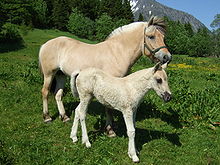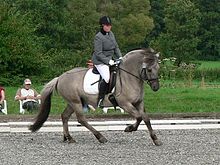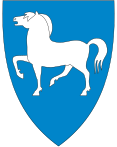Fjord horse
 | |
| Other names |
|
|---|---|
| Country of origin | Norway |
| Standard | |
TheFjordorNorwegian Fjord Horse(Norwegian:fjordhest) is a relatively small but very stronghorse breedfrom the mountainous regions ofwestern Norway.It is an agile breed of lightdraught horsebuild. It is alwaysdunin colour, with five variations in shade recognised in thebreed standard.One of the world's oldest breeds, it has been used for hundreds of years as afarm horsein Norway, and in modern times is popular for its generally good temperament. It is used both as aharness horseand under saddle.
History
[edit]The Fjord is one of the world's oldest and purest breeds. Horses were known to exist in Norway at the end of the last ice age. It is believed that its ancestors migrated to Norway and were domesticated over4000years ago. Archaeological excavations atVikingburial sites suggest that horses of this type have been selectively bred for at least2000years.[1][2]The horses were used by the Vikings as war mounts, and have been used for hundreds of years as farm animals in westernNorway.Even as late asWorld War II,they were useful for work in mountainous terrain. Its strength, durability and thick coat fare well in the rough winters of Norway.[2]
The breed has a long history of pure breeding withoutcross-breedingfrom other sources.[2]
Characteristics
[edit]Theconformationof the Norwegian Fjord Horse differs from that of many other breeds in that it is a blend ofdraught horsemuscling and bone, with smaller size and greater agility. It has a strong, arched neck, sturdy legs and good feet, and a compact, muscular body. The head is medium-sized and well defined with a broad, flat forehead and a straight or slightly dished face, with small ears and large eyes.[1]Despite its small size, the breed is fully capable of carrying an adult human and pulling heavy loads. The hair coat becomes particularly heavy and thick in the winter.
The naturalmaneis long, thick, and heavy, but is usually clipped in a distinctive crescent shape to between 5 and 10 cm (2.0 and 3.9 in) so that it stands straight up and emphasises the shape of the neck.[1]This roached mane is thought to make for easier grooming. It also accentuates the horse's strong neck and full-length dorsal stripe. There is somefeatheringon the lower legs; however, the breed standard discourages profuse feathering.[3]
There is no upper or lower limit for height set for the breed, but heights between 135 and 150 cm (13.1 and 14.3hands;53 and 59 inches) at thewithersare recommended.[4] [2]The weight normally ranges from 400 to 500 kilograms (880 to 1,100 lb).[1]
Colour
[edit]
Most of the horses aredun.[1][5]Dun is a body colour that is a tan, gold or related shade with darker (usually black or dark brown)pointsandprimitive markings.The breed standard recognises five shade variations.[3]These shades have been officially recognised in Norway since 1922.[5]The hooves are most often dark, but can be a lighter brown colour on lighter-coloured horses.[3]
Theduncolour itself is adominantdilution gene.All the horses are dun; therefore, they arehomozygousor nearly so for dun colouration.[6]Noequine coat colour geneticsstudies have been done specifically on the horses; but if they were not homozygous for the dun gene, then a dark-coloured, non-dun individual could occasionally occur. However, this is very rare or non-existent today; darkcropoutsexisted in the past, but breed standardisation has favoured duns and the colour is now produced consistently.[5]

Theprimitive markingsassociated with the dun gene are often quite vivid. These include the dorsal stripe, darker mane and tail, horizontal stripes on the back of the forearms, and, in rare cases, transverse striping across thewithers.[5]Some horses havesmall brown spotson the body or the head.[3]These spots are called "Njal marks" after one of thefoundation siresof the breed, who had such markings.[5]The horses are also consistent for havingpangaretraits: lighter hair on the muzzle, belly, inside of legs, and over the eyes.[5]Some also carry thecream gene,which combines with the dun gene to create the lighter shades of the breed.[6]
The horses have a significant amount of lighter hairs on the outside edges of themaneand edges of the tail, and when teamed with the darker-coloured centre of the mane common to most colour shades gives a two-toned look that is more dramatic than seen in dun horses of other breeds.[7] The dark section of hair in the middle of the mane and the darker hair in the middle of the tail are described by the Norwegian termsmidtstolandhalefjær,respectively.[5]
White markings are rare,[5][8]but have been noted as long as written records have been kept of the breed.[5]A small star is acceptable,[3]but any other white or pink markings are considered undesirable.[5]Norges Fjordhestlag(The Norwegian Fjord Horse Association) decided in 1982 that stallions of any age with any other white markings than a small white star cannot be accepted for breeding.[5]
Recognized shades
[edit]
The breed standard recognises five colours. 90% of all the horses are "brown dun" (the colour called "bay dun" in other breeds).[1]The remaining 10% are either "red dun", "grey" (less often "grey dun", the colour known asmouse dunin other breeds), or two colours reflecting the influence of the cream gene: "white dun" (or "uls dun" ) and "yellow dun".[5]Thebreed associationencourages preservation of all colours.[3]The dun colour variations can be subtle and hard to distinguish unless horses of different shades are standing side by side. The colour terms are also non-standard when compared to English terminology more commonly used to describehorse coat coloursin other breeds. This difference appears to be based in part from being derived fromNorwegian-languageterms, which were set in 1922, and their English translations, which were made official in 1980.[5]While these terms were set beforeequine coat colour geneticswere fully understood, the variations do match up to modern genetic studies as variations of dun colour with the addition of other genetic factors.
- Brown dun(brunblakk) is the most common colour.[5]The body colour is a pale yellow-brown, and can vary from cream to almost a lightchestnut.The primitive markings, as well as themidtstolandhalefjær,are black or dark brown. The remainder of the mane and tail is usually cream or white, though may be a darker on darker individuals.[5]The colour is geneticallybaydiluted by thedun factor,called "dun", "bay dun" or "zebra dun" in other breeds.

- Thered dun(rødblakk) has a pale golden body colour.Midtstol,halefjærand primitive markings are red or red-brownish, always darker than the colour of the body, but never black. The rest of the mane and tail is usually cream, though on some individuals the entire mane and tail may be white.[5]Like red duns in other breeds, this shade is produced by the dun factor diluting a geneticchestnutbase colour.

- The "grey"(grå) has a grey body; the shade can vary from light silver to dark slate grey. Themidtstol,halefjærand primitive markings are dark grey or black.[5]The remainder of the mane, tail and forelock are a lighter grey than the body colour, and can be very pale. Though the term used in the breed standard for this colour isgrey,[3]it is actually a form of dun and not a true geneticgrey.The termgreyand evengrey dunaremisnomers,as the Fjord gene pool does not carry thegreying gene.The term used for this colour in other breeds and bygeneticistsismouse dunor blue dun. As in other breeds, the "grey" body colour is produced by the dun factor diluting a geneticblackbase colour. The termgrey dunorgråblakkis sometimes used to describe this colour, but among Fjord owners, that terminology is considered incorrect even if more consistent. Had English-speaking Fjord breeders used the same naming conventions as for their breed's other shades, the colour could genetically be called a "black dun,"[5]but this did not happen.
- Thewhite dunoruls dun(ulsblakk) has a cream body colour. Themidtstol,halefjærand primitive markings are black or off-black. The rest of the mane and tail are lighter than the body colour.[5]The colouration is genetically a bay-based dun furtherdilutedby a singlealleleof thecream gene,what is sometimes called a "buckskin dun" in other settings.[6]
- Theyellow dun(gulblakk) is the rarest colour aside fromkvit(see below).[5]It is a red dun with an additional dilution factor that makes the body a light cream colour. This also due to the cream gene.[6]The forelock, mane and tail can be completely white, and the primitive markings can be indistinct.[5]
Kvit,'white'
[edit]Along with the recognised five shades of dun,two cream dilutionalleles(CCr) on any other colour results in a horse with a light cream coat colour and blue eyes. This colour is calledkvit('white') in Norwegian, and is known ascremello, perlino or smoky creamin other breeds. A dun with double cream dilution will have faint or indistinguishable primitive markings.[8]In the Fjord,kvitwas traditionally considered undesirable, and thus is a very rare colour in the breed due to intentional selection against it.[8]Nonetheless, it is a normal colour within the gene pool, as the nature of cream genetics statistically will result in the occasionalkvithorse any time two horses that both carry a single copy of the cream dilution are mated, such as anulsblakkand/or agulblakk.[6]
Use
[edit]
The Fjord is strong enough for heavy work, such as ploughing fields or hauling wood, yet light and agile enough to be a good riding and driving horse. It is alsosure-footedin the mountains. It is common at Norwegian riding andtherapeutic schools,as its generally mild temperament and small size make it suitable for children and disabled individuals. It is considered a goodharness horse,and is commonly used in competition and in tourist transport.
Norwegian Fjord Horse Centre
[edit]TheNorwegian Fjord Horse Centre(Norwegian:Norsk Fjordhestsenter) inNordfjordeidis the national resource centre for the Fjord Horse in Norway. It was established in 1989 and is owned by the Norwegian Fjord Horse Association,Stad Municipalityand theVestland Countyauthority.
Breed associations
[edit]- USA Norwegian Fjord Horse Registry
- Canadian Fjord Horse Association
- Belgisch Fjordenpaardenstamboek (Belgian stud-book)
- Fjordhesteavlen i Danmark (Danish stud-book)
- Fjord Horse National Stud Book Association of Great Britain
- Norges Fjordhestlag
- Norsk Hestesenter
- Svenska Fjordhästföreningen (Swedish stud-book)
- Fjordpferde Vereinigung Schweiz (Swiss stud-book)
- Het Nederlandse Fjordenpaarden Stamboek (Dutch stud-book)
- Interessengemeinschaft Fjordpferd (German stud-book)
- Suomen Vuonohevosyhdistys ry (Finnish stud-book)
See also
[edit]References
[edit]- ^abcdef"About the Breed",published by Norwegian Fjord Horse Registry. Web site accessed 7 December 2009
- ^abcdBreeding plan in Norway (7 June 2020)Fjord Horse International AssociationOld link archived:Archived29 September 2007 at theWayback Machine,accessed 7 December 2009
- ^abcdefgNFHR Breed standardaccessed 3 December 2009
- ^Styret i Norsk Hestesenter (7 June 2020).Avlsplan for fjordhestOld link archived:Archived21 October 2014 at theWayback Machine(in Norwegian). Norsk Hestesenter. Accessed October 2014.
- ^abcdefghijklmnopqrstu"The Colours of the Norwegian Fjordhorse",accessed 23 January 2012
- ^abcdeSponenberg, Phillip."Color in Fjord Horses".Norwegian Fjord Horse Registry.Retrieved20 January2010.
- ^"Breed Standard".Norwegian Fjord Horse Registry.Retrieved28 May2017.
- ^abcNorwegian Fjord Horse at horse-genetics,accessed 4 December 2009]
External links
[edit]- USA Norwegian Fjord Horse Registry
- Canadian Fjord Horse Association
- Belgisch Fjordenpaardenstamboek (Belgian stud-book)(in Dutch and French)
- Fjordhesteavlen i Danmark (Danish stud-book)(in Danish)
- Fjord Horse National Stud Book Association of Great Britain
- Norges Fjordhestlag(in Norwegian)
- Norsk Hestesenter(in Norwegian)
- Svenska Fjordhästföreningen (Swedish stud-book)(in Swedish)
- Fjordpferde Vereinigung Schweiz (Swiss stud-book)(in German)
- Het Nederlandse Fjordenpaarden Stamboek (Dutch stud-book)(in Dutch)
- Interessengemeinschaft Fjordpferd (German stud-book)(in German)
- Suomen Vuonohevosyhdistys ry (Finnish stud-book)(in Finnish)


